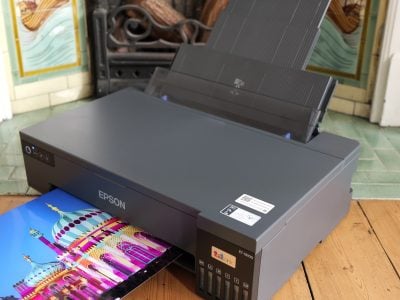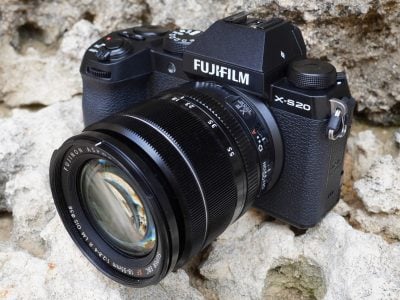Canon PowerShot G11
-
-
Written by Gordon Laing
Canon PowerShot G11 verdict
Canon’s PowerShot G11 continues the G-series’ proud tradition of delivering high-end features and full manual control in a compact form factor. This is a well-built camera which will greatly appeal to enthusiasts.
Like previous models in the series, the G11 shares much in common with its predecessor, but makes a handful of evolutionary changes to satisfy demands – although revealingly two of the major ‘advances’ here are actually blasts from the past. After many pleas, Canon’s finally brought back an articulated screen, a feature not seen since the G6 back in 2004. It’s also reduced the resolution to the same 10 Megapixels of the G7 2006 model.
It seems ironic the major new features are in fact ones we’ve seen before on the G-series, but Canon’s been playing a gradual game of catch-up since the G7 unforgivably dropped RAW recording, a flip-out screen, a bright f2.0 lens and an upper LCD panel from the feature-list. RAW was reinstated with the G9 and now two models later we’ve got the flip-out screen back again. Who knows, maybe next year we’ll get the fast lens.
 |
To be fair to Canon, both the screen and sensor on the G11 are at least new models. The screen uses a 2.8in panel, which may be a little smaller than the 3in panel of the previous G10, but shares the same 460k resolution for a crisp, detailed image, and of course now becomes fully-articulated for easy composition at unusual angles.
 |
As mentioned in the main review, the screen may not quite flip out by a full 180 degrees, causing a little disorientation when framing at waist-level, but it seems a little churlish to complain when we’ve been requesting its return for so long. It’s a welcome upgrade, but next time Canon, please ensure the screen can flip-out by the full 180 degrees.
As for the sensor, its resolution and physical size may match that of the old G7, but Canon assures us it’s a new chip; it can certainly operate at much higher sensitivities anyway. And this is partly what’s behind Canon’s decision to reduce the resolution from 14.7 to 10.0 Megapixels here: better low-light performance.
In practice it bears-out too, with the G11 delivering noise levels at least one stop better than its predecessor above 200 ISO. Canon’s also been very clever about its noise reduction, keeping visible textures under control at higher sensitivities with only a gradual reduction in saturation and fine detail giving the game away. Even the 12,800 ISO top sensitivity in Low Light mode can deliver acceptable images when shrunk further for emailing or web applications. Indeed we’d say the G11 has one of the best ‘small-sensor’ performances we’ve seen to date, although it’s important to consider the bigger picture – literally.
The G11 may look better than the G10 at higher sensitivities, but that doesn’t necessarily mean you’d want to use them. At 400 ISO it’s acceptable, but at 800 ISO and up, the quality is unsurprisingly suffering when viewed at 100%. As always, the best results are had at 200 ISO and below, but it’s important to remember the G10 also looked good at these settings, while recording finer detail thanks to its higher resolution sensor. So if you can restrict yourself to shooting at the lowest sensitivities, the earlier G10 could actually be a better bet. And if you want really decent performance at higher ISOs, you should really be looking at a camera with a bigger sensor like a DSLR or the Micro Four Thirds compacts from Olympus and Panasonic.
This puts the G11 in a slightly tricky position in terms of image quality, although it still comes in comfortably cheaper than the Micro Four Thirds compacts, while squeezing a bigger zoom and articulated screen into a smaller package. It’s also important to note at 80 ISO under bright light, the G11 delivered a similar-looking image to the E-P1 and GF1 in our tests.
 |
Speaking of the lens, it may be unchanged from the earlier G10, but the 5x zoom still delivers a decent general-purpose range from wide angle to respectable telephoto, not to mention 1cm macro close-ups, while also including effective stabilisation to iron-out the wobbles. It’s well-corrected too.
The G11 also inherits a variety of other useful features from the G10, including full manual exposures, RAW recording, a flash hotshoe and a number of decent physical controls with tactile handling. Beyond the articulated screen, the body’s essentially identical too, and as such is built like a solid brick which is surprisingly comfortable to hold and use given the relatively minor grip.
But the G11 is more than just a G10 with a flip-out screen and 10 Megapixel sensor. Canon’s also equipped it with scene recognition in Auto, new Low Light and Quick shot modes (the former allowing you to shoot at up to 12,800 ISO albeit at 2.5 Megapixels), and an HDMI port. Annoyingly the G10’s handy sound recorder and Superfine JPEG options are no longer present though.
Of greater concern though is the movie mode, again inherited wholesale from the G10, and as such operating at nothing higher than VGA. That’s right, there’s still no HD or widescreen options, and to add insult to injury, you still can’t optically zoom the lens while filming either. Canon explains this is due to a technical limitation, but in terms of the current marketplace, it’s unforgivable to release a premium compact in 2009 without HD video.
Bizarrely given the reduced resolution, it’s also disappointing to find the already paltry continuous shooting rate of the G10 is even slower here at a mere 1.1fps under best conditions. The G11’s new Low Light mode may boost this to 2.4fps by reducing the resolution to 2.5 Megapixels, but it’s revealing to note Panasonic’s year-old LX3 matches this speed at its full resolution (for eight frames), or increases it to 6fps when dropped to 3 Megapixels. So while we’re pleased to see Canon offering a faster option at a reduced resolution, it still falls below what we’d expect from a model of its calibre.
So before our final wrap-up, how does the PowerShot G11 compare against its rivals?
Compared to Canon PowerShot G10
We’ll start with the PowerShot G10, the G11’s predecessor. As discussed above, the older G10 shares a great deal with the new model including the same 5x optical zoom, flash hotshoe, RAW recording and manual exposure modes. It also shares essentially the same body, battery, controls and optical viewfinder.
The major differences are the sensor and screen. The G10 actually has a higher resolution sensor with 40% more pixels in total: 14.7 Megapixels to the new model’s 10. Canon’s pitching the lower resolution of the new G11 as being advantageous to noise levels, and this is certainly true, but at the 80-200 ISO range where you should try and keep any (small sensor) compact, the two cameras suffer from similar noise levels, and the extra resolution of the G10 allows it to record slightly finer details. It’s not the difference of night and day, but if you can keep it at the lowest sensitivities, the G10 will out-resolve the new model.
In terms of the screen, the new G11 boasts a fully-articulated model to its predecessor’s fixed monitor, but both share the same 460k resolution and the older G10’s is slightly larger at 3in. And while the new G11 features scene detection, higher sensitivities and an HDMI port, it’s lacking the handy sound recorder and superfine JPEG compression options of the G10. The inclusion of HD movies (or even simply being able to zoom while filming) could have further differentiated the G11 from its predecessor, but both actually share the same video options.
So while the G11 certainly has a number of benefits over its predecessor, there’s still compelling reasons to want the older G10 instead. If the G10’s price falls, then it becomes even more tempting, although we wouldn’t be surprised if it remains just below that of the G11. If you’re happy to shoot below 200 ISO and don’t need the flip-out screen, it’s a great choice. See our Canon PowerShot G10 review for more details.
Compared to Olympus E-P1
The Olympus E-P1 was the first compact to employ the Micro Four Thirds standard, and while it costs 50% more than the PowerShot G11, they’re both targeting the same audience of demanding enthusiasts who want a pocketable, but powerful camera.
That extra budget gets you a much bigger sensor, which performs better in low light and in terms of dynamic range. If you shoot below 200 ISO, the G11’s image quality is actually pretty close to the E-P1, but crank-up the sensitivity and the bigger sensor enjoys a clear advantage. The E-P1 also supports a growing choice of removeable lenses, features superior continuous shooting, and has 720p HD video recording capabilities.
In its favour, the G11 is a little smaller and lighter than the E- P1 even when fitted with its smallest fixed lens – and remember with the G11 you’re getting a built-in 5x zoom which retracts almost flush to the body when powered-down. The E-P1’s screen may be a little bigger, but the G11’s is much more detailed and flips-out to any angle. The G11 also features a built-in optical viewfinder and flash, both of which are optional accessories for the E-P1. And while the E-P1 adopts retro-styling, for our money we actually preferred the controls on the G11.
There’s a number of other features which could be factored-in, but really it boils down to whether you’re willing to pay around 50% more for a slightly larger body which has the benefit of a much bigger sensor, interchangeable lenses (all of which become stabilised by the body) and HD video. See our Olympus E-P1 review for more details.
Compared to Panasonic Lumix DMC-GF1
The Lumix GF1 is actually Panasonic’s third camera to employ the Micro Four Thirds standard, but the first from the company to adopt a compact form factor. Like the Olympus E-P1 above, it costs over 50% more than the G11, but again targets the same audience and shares much the same advantages.
As such, the major benefit remains a physically larger sensor with superior performance in low light and a broader dynamic range. Again, if you shoot below 200 ISO, the G11’s image quality is actually pretty close to the GF1, but increase the sensitivity and the bigger sensor enjoys a clear advantage. The GF1 also supports a growing choice of removeable lenses, features superior continuous shooting, and has 720p HD video recording capabilities which are sorely lacking from the G11.
In its favour, the G11 is a little smaller and lighter than the GF1 even when fitted with its smallest fixed lens – and remember with the G11 you’re getting a built-in 5x zoom with stabilisation which retracts almost flush to the body when powered-down. The GF1’s screen may match the 460k resolution of the G11 and also be a little bigger, but the G11’s flips-out to any angle. The G11 also features a built-in optical viewfinder, whereas the viewfinder is an optional accessory for the GF1, although in its favour it’s an electronic model with 100% coverage and superimposed graphics.
There’s a number of other features which could be factored-in, but like the E-P1 above, really it boils down to whether you’re willing to pay around 50% more for a slightly larger body which has the benefit of a much bigger sensor, interchangeable lenses and HD video. See our Panasonic Lumix GF1 preview for more details and check back soon for our full review.
Compared to Panasonic Lumix DMC-LX3
Panasonic’s Lumix DMC-LX3 was the major rival for the earlier G10, and remains a viable alternative one year on against the latest model. Both cameras offer manual control, flash hotshoes, RAW recording, high resolution screens and wide angle coverage in relatively pocketable form factors, and they now also share the same 10 Megapixel resolution to better-manage noise. Despite these similarities though, there remain a number of key differences between them.
In its favour, the LX3’s lens has wider-angle coverage equivalent to an impressive 24mm, while additionally boasting a brighter focal ratio of f2.0-2.8. The LX3 can also record 720p HD video, along with offering quicker continuous shooting options of either 2.5fps at the full resolution (for eight standard JPEGs), or 6fps at a reduced resolution of 3 Megapixels. The camera itself is also comfortably smaller and around one third lighter.
It’s far from a one-sided argument though. Most obviously the PowerShot G11 may not zoom as wide, but it has double the optical range, allowing it to zoom-in much closer to an equivalent of 140mm compared to the LX3’s 60mm. Both cameras may sport 460k screens, but the G11’s is fully-articulated. The G11 also features an optical viewfinder, which can greatly extend the battery life, or eek-out a few extra shots when the power’s running low.
As before it’s a case of swings and roundabouts, with the choice boiling down to which feature-set and zoom range best suits your requirements, along with which model looks and feels best to you in person. See our Panasonic Lumix DMC LX3 review for more details.
Compared to Canon PowerShot SX20 IS
If you want a Canon with an articulated screen, flash hotshoe, HD video with stereo sound, HDMI port and a considerably longer 20x optical zoom range, then consider the PowerShot SX20 IS. The SX20 IS offers all this and more at an even lower price than the G11, so what’s the catch?
Well, the SX20 IS doesn’t have RAW recording and with a 2.5in / 230k screen, it’s both smaller and less detailed than the G11’s 2.8in / 460k monitor. The SX20 IS is also lacking the Low Light and Quick Shot modes, along with the tactile control dials of the G11, and it’s not as pocketable either. The SX20 IS’s sensor may have two more Megapixels, but it’s physically smaller, so noise really does become an issue sooner.
But the combination of features listed at the start of this paragraph at a more affordable price justifiably makes the SX20 IS one of the best-sellers in the current Canon range; indeed if you’re looking for a partner for an existing DSLR which offers a noticeably different feature-set, then it’s arguably a better choice. See our Canon PowerShot SX20 IS review for more details.
Compared to Canon PowerShot S90
Canon’s PowerShot S90 is another model to consider as it shares a great deal in common with the G11. Both cameras share full manual control, support for RAW files, screens with 460k resolution, HDMI ports and the same sensor, which in turn means they also sadly have the same basic VGA movie facilities.
By sharing the same sensor, the noise levels and overall image style are also unsurprisingly the same, although the G11 enjoys a small edge in sharpness and uniformity across the frame. Beyond these initial similarities though, both cameras represent quite different propositions.
In its favour the G11 has a fully-articulated (albeit slightly smaller 2.8in) screen which can flip and twist to any angle, along with an optical viewfinder which is handy in direct sunlight or for squeezing a few extra shots out of a failing battery. Both lenses start at an equivalent of 28mm, but the G11’s zooms almost 40% longer to 140mm, allowing it to better grab distant details, and as mentioned above, it was also a little sharper in our tests.
There’s a hotshoe for mounting proper Speedlite flashguns, dedicated dials for the ISO and exposure compensation, and while the body is considerably larger and heavier, it lends it a greater air of confidence, while additionally giving you more to hold onto and a longer battery life.
In its favour, the S90 is considerably smaller and lighter, features a lens with a brighter f2.0 focal ratio when zoomed-out, a slightly larger 3in screen and a neat lens ring control.
The S90 essentially packs the quality and control of the G11 into a much smaller and lighter package with a brighter lens, and as such arguably becomes a more compelling camera for anyone looking for a powerful compact. If you can live without the articulated screen, flash hotshoe, and optical viewfinder, the S90 could be a better choice. Think of it as the Digital IXUS / ELPH for demanding photographers. See our Canon PowerShot S90 review for more details.
Canon PowerShot G11 final verdict
The PowerShot G11 continues Canon’s strategy for recent G-series models by essentially taking the previous version, adding a handful of new features and reinstating some from earlier classics. In the former camp, the G11 now features scene detection, new Low Light and Quick Shot modes, along with an HDMI port, while in the latter category we can finally welcome back a flip-out screen, not seen on the PowerShot G-series since the G6 back in 2004. Indeed it seems amazing we’re still playing catch-up in some respects with a model that’s over five years old – who knows, next year we might even see the return of an optically bright lens, especially now the recent S90 has dipped a toe in that particular pond.
The headline feature of the G11 is its low light capability with Canon taking a sensible reverse-turn on its earlier obsession with Megapixels. It works too, with the G11’s lower resolution allowing it to perform at least one stop better than its predecessor, and while the Low Light mode ain’t pretty at a reduced resolution of 2.5 Megapixels, it’s still impressive to shoot in near darkness without a flash at 12,800 ISO.
 |
Interestingly though this doesn’t necessarily make the G11 a better camera than its predecessor. Sure the flip-out screen is a nice addition, but if you can force yourself to shoot at the lowest sensitivities, you can exploit the earlier G10’s higher resolution for slightly more detailed images without incurring too much noise. Canon seems to realise this and the G10 should remain on sale alongside the G11 at least until stocks last. So that makes the decision easy: if you’re happy shooting at the lowest sensitivities, get the G10, but if you want better quality at higher ISOs or fancy the flip-out screen, then get the G11.
But that’s just considering Canon’s world. While Panasonic may not have updated its LX3 this year, the G11 is not without new competition in the high-end compact market. The past year has seen the introduction of the Micro Four Thirds format with the highly compelling Olympus E-P1 and Panasonic GF1 targeting the same audience who’d normally be weighing-up the Lumix LX and PowerShot G models.
The G11 may have improved noise levels over the G10 and most traditional compacts, but can’t compete with the physically larger sensors of the E-P1 and GF1. The G11 may also have a nice built-in 5x zoom with stabilisation, 28mm wide angle and great close-up capabilities, but the E-P1 and GF1 have the benefit of removeable lenses and a range which already includes ultra-wide zooms, telephotos and fast primes. Sure, fitting anything but the pancake primes will make the E-P1 and GF1 bigger overall than the G11, but they’re still much smaller than a DSLR. And while neither the E-P1 nor GF1 have a flip-out screen nor a built-in optical viewfinder, they do have 720p HD video, a killer feature that’s sorely lacking on the G11.
Of course the E-P1 and GF1 also cost over 50% more than the G11, but while this would normally make them an unfair comparison in other categories, the fact is all three are targeting the same market: generally well-heeled photographers who are willing to adjust their budget for a quality compact with manual controls to act as a partner for a DSLR, or in some cases, a replacement.
This places the PowerShot G11 in a tricky position. If you’re willing to shoot at the lowest sensitivities, the earlier G10 will out-resolve it, and if you’re really serious about decent low light performance, you should be looking at a camera with a bigger sensor, like the E-P1 or GF1. Or if you’re after a compact with a different feature-set to complement an existing DSLR, the PowerShot SX20 IS or S90 are also compelling options.
That’s not to say the G11 is a poor camera – on the contrary it’s a really nice piece of kit which handles well, performs better than most traditional compacts in low light, and comes recommend if it fits your needs or budget. But we believe much of its target audience would be better-served by a Micro Four Thirds model, or an alternative PowerShot such as the G10, S90 or even SX20 IS.
Canon has to think very carefully about the future direction of the G-series. It’s been a wonderful range but as the company dawdled at reinstating killer features of models-past, the competition has moved on to deliver the enthusiast’s dream of a big sensor and removeable lenses in a compact body with the bonus of HD video – and even at a 50% higher price, that’s a tough proposition to beat.
Bad points | Scores (relative to 2009 compacts) |
 | ||
Build quality: Image quality: Handling: Specification: Value:
Overall: |
19 / 20 18 / 20 16 / 20 18 / 20 17 / 20
88% | |||










